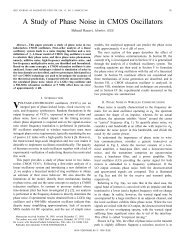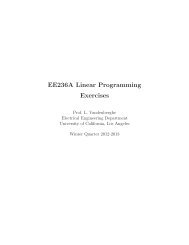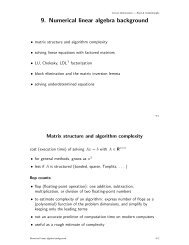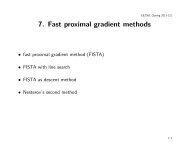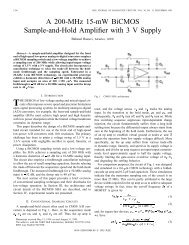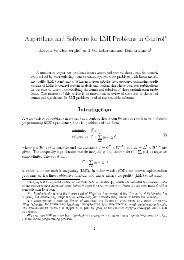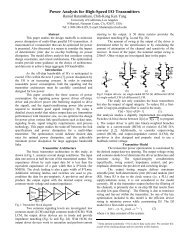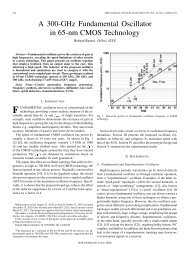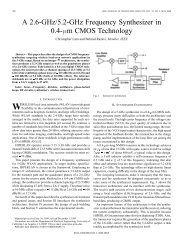60 GHz CMOS Amplifiers Using Transformer- Coupling and Artificial ...
60 GHz CMOS Amplifiers Using Transformer- Coupling and Artificial ...
60 GHz CMOS Amplifiers Using Transformer- Coupling and Artificial ...
Create successful ePaper yourself
Turn your PDF publications into a flip-book with our unique Google optimized e-Paper software.
IEEE JOURNAL OF SOLID-STATE CIRCUITS, VOL. 44, NO. 5, MAY 2009 1425<br />
<strong>60</strong> <strong>GHz</strong> <strong>CMOS</strong> <strong>Amplifiers</strong> <strong>Using</strong> <strong>Transformer</strong>-<br />
<strong>Coupling</strong> <strong>and</strong> <strong>Artificial</strong> Dielectric Differential<br />
Transmission Lines for Compact Design<br />
Tim LaRocca, Member, IEEE, Jenny Yi-Chun Liu, Student Member, IEEE, <strong>and</strong><br />
Mau-Chung Frank Chang, Fellow, IEEE<br />
Abstract—57–65 <strong>GHz</strong> differential <strong>and</strong> transformer-coupled<br />
power <strong>and</strong> variable-gain amplifiers using a commercial 90 nm<br />
digital <strong>CMOS</strong> process are presented. On-chip transformers combine<br />
bias, stability <strong>and</strong> input/interstage matching networks to<br />
enable compact designs. Balanced transmission lines with artificial<br />
dielectric strips provide substrate shielding <strong>and</strong> increase the<br />
effective dielectric constant up to 54 for further size reduction.<br />
Consequently, the designed three-stage power amplifier occupies<br />
only an area of only 0.15 mmP . Under a 1.2 V supply, it consumes<br />
70 mA <strong>and</strong> obtains small-signal gains exceeding 15 dB, saturated<br />
output power over 12 dBm <strong>and</strong> associated peak power-added<br />
efficiency (PAE) over 14% across the b<strong>and</strong>. The variable-gain<br />
amplifier, based on the same principle, achieved a peak gain of<br />
25 dB with 8 dB of gain variation.<br />
Index Terms—<strong>CMOS</strong>, differential amplifiers, millimeter-wave<br />
amplifiers, power amplifiers, transformers.<br />
I. INTRODUCTION<br />
A<strong>CMOS</strong> transformer-coupled power amplifier <strong>and</strong> variable-gain<br />
amplifier for the unlicensed 57–64 <strong>GHz</strong><br />
spectrum are presented with high efficiency <strong>and</strong> compact<br />
designs. The <strong>60</strong> <strong>GHz</strong> spectrum continues to grow in interest<br />
due to the anticipated dem<strong>and</strong> for high-data rate, short-distance<br />
communication ( 10 m) as well as the proven capability to<br />
fabricate a low-cost, high- st<strong>and</strong>ard digital <strong>CMOS</strong> process<br />
[1]. It is widely recognized that <strong>CMOS</strong> is the technology<br />
choice in order to be successful in a high-volume market<br />
due its cost, however, the designs must be area constrained.<br />
Typically, millimeter-wave power <strong>and</strong> variable-gain amplifiers<br />
are designed using an expensive, high-performance, but less<br />
available III-V based semiconductor technology. The designs<br />
utilize st<strong>and</strong>ard high-frequency passive structures such as<br />
a Wilkinson combiner or Lange couplers to effectively power<br />
combine single-ended designs, <strong>and</strong> the matching networks<br />
use long transmission lines. Unfortunately, cost <strong>and</strong> size are<br />
major drawbacks. This paper presents a methodology using<br />
on-chip artificial dielectric differential transmission lines <strong>and</strong><br />
transformers to simultaneously achieve high performance <strong>and</strong><br />
Manuscript received August 20, 2008; revised December 15, 2008. Current<br />
version published May 01, 2009. This work was supported by the Defense Advanced<br />
Research Projects Agency (DARPA) TEAM program <strong>and</strong> the Northrop-<br />
Grumman Corporation. Foundry support was provided by UMC.<br />
The authors are with the Department of Electrical Engineering, University of<br />
California, Los Angeles, CA 90095 USA (e-mail: tlarocca@ee.ucla.edu).<br />
Color versions of one or more of the figures in this paper are available online<br />
at http://ieeexplore.ieee.org.<br />
Digital Object Identifier 10.1109/JSSC.2009.2015794<br />
0018-9200/$25.00 © 2009 IEEE<br />
Fig. 1. Differential transmission line with floating artificial dielectric strips.<br />
minimal size to allow a high level of integration within a<br />
low-cost <strong>60</strong> <strong>GHz</strong> <strong>CMOS</strong> transceiver.<br />
<strong>Artificial</strong> dielectric strips, as shown in Fig. 1, are inserted beneath<br />
a differential line [2], [3] <strong>and</strong> coplanar waveguide [4] on<br />
<strong>CMOS</strong> as a method to reduce the physical length of the transmission<br />
line by increasing the effective dielectric constant while<br />
simultaneously confining the electric field above the conductive<br />
substrate. Measurements confirm the improved loss per radian<br />
performance of a differential transmission line with artificial<br />
dielectric strips in Section II. Moreover, this technique<br />
is highly suitable for a st<strong>and</strong>ard, digital <strong>CMOS</strong> process with<br />
multiple metal interconnect layers (nine for the UMC 90 nm<br />
1P9M). It is used in this paper as a differential line for the I/O<br />
feed network <strong>and</strong> output stub matching elements for the aforementioned<br />
purposes. The strips can dramatically increase the<br />
dielectric constant to above 54 even though the dielectric constant<br />
of silicon dioxide <strong>and</strong> of silicon is roughly 4.1 <strong>and</strong> 11.9, respectively.<br />
This new on-chip reactive technology is important as<br />
this paper advocates moving away from the traditional paradigm<br />
of single-ended designs using shielded microstrip or coplanar<br />
waveguide. This paper will also explain the critical differences<br />
between using artificial dielectric transmission lines for open<br />
<strong>and</strong> shorted stubs in impedance matching networks.<br />
<strong>Transformer</strong> coupled power amplifiers have been introduced<br />
at lower frequencies [5]–[7], but only recently have transformers<br />
been used as a millimeter-wave element, [8]–[11]. In [9], we<br />
illustrated the effectiveness of the on-chip transformer in millimeter-wave<br />
<strong>CMOS</strong> power amplifier design for compactness<br />
<strong>and</strong> highest reported performance in efficiency, gain <strong>and</strong> associated<br />
saturated power. This is accomplished by combining<br />
the functionality of RF matching, stabilization <strong>and</strong> DC biasing
1426 IEEE JOURNAL OF SOLID-STATE CIRCUITS, VOL. 44, NO. 5, MAY 2009<br />
Fig. 2. Circuit schematic of differential, transformer coupled <strong>CMOS</strong> power amplifier.<br />
networks in the transformer design. This paper examines the<br />
transformer performance with measured <strong>and</strong> simulated data, <strong>and</strong><br />
gives a step-by-step discussion of its matching ability in amplifier<br />
designs. In addition, we report on a transformer coupled<br />
variable-gain amplifier in series with the power amplifier<br />
to further highlight the transformer as a millimeter-wave amplifier<br />
element. This circuit is the gain block for the system level<br />
transceiver design. In summary, unlike the traditional singleended<br />
<strong>CMOS</strong> MMIC [12]–[16], the developed <strong>60</strong> <strong>GHz</strong> power<br />
<strong>and</strong> variable-gain amplifiers have exploited differential circuit<br />
architecture <strong>and</strong> taken full advantage of on-chip transformer<br />
coupling <strong>and</strong> artificial dielectric transmission lines to accomplish<br />
more effective impedance matching <strong>and</strong> power combining,<br />
higher output power <strong>and</strong> higher power-added efficiency (PAE)<br />
utilizing less silicon real estate consumption.<br />
II. ARCHITECTURE<br />
The power amplifier is a three-stage, cascaded design using<br />
the UMC 90 nm 1P9M (nine metal layers) st<strong>and</strong>ard digital<br />
process with the schematic shown in Fig. 2. A common-source<br />
NMOS configuration with a 1.2 V supply voltage is used, maximizing<br />
current <strong>and</strong> voltage swings. The total gate peripheries<br />
of the pre-driver <strong>and</strong> driver stages are minimized in size to<br />
maintain a lower quiescent current <strong>and</strong> preserve efficiency with<br />
the exact value determined by analysis which will be elaborated<br />
on later. A differential transmission line <strong>and</strong> symmetric, shorted<br />
stub with on-chip artificial dielectric strips are used for the<br />
output match, while differential transformers are designed for<br />
inter-stage <strong>and</strong> input matching.<br />
The variable-gain amplifier (VGA) is also a three-stage,<br />
cascaded design using the same process, but each stage is<br />
a differential cascode pair. A differential, cascode pair is a<br />
common topology for variable-gain design [17]. Gain variation<br />
is achieved by controlling the operating region (linear or<br />
saturation) in the common-source transistor in Fig. 3. It is<br />
important to note that even though the cascode pair may offer<br />
some stability advantages, the layout must be well simulated to<br />
prevent the common-gate transistor from unwanted triggering<br />
of the amplifier instability. An inductor is inserted in series between<br />
the cascode pair to increase gain by improving the match<br />
between the capacitive loads, as well as to further improve<br />
stability. This concern for stability is important. In accordance<br />
with the Rollet Stability Factor <strong>and</strong> stability measure, the<br />
90 nm gate length devices are only conditionally stable below<br />
40–<strong>60</strong> <strong>GHz</strong>, <strong>and</strong> thus are prone to oscillation if incorrectly<br />
loaded or by feedback, most likely through a bias line. We<br />
also emphasize the size reduction achieved by using on-chip<br />
differential transformers <strong>and</strong> artificial dielectric transmission<br />
lines for inter-stage <strong>and</strong> input matching functionality, as used<br />
in the VGA.<br />
A. Differential Design Approach<br />
The matching networks, input/output feed structures <strong>and</strong><br />
lumped components are based on a two-port differential signal.<br />
This was chosen because it has ramifications on size, testing,<br />
biasing <strong>and</strong> even stability. We begin this discussion with the<br />
choice of passive transmission line technology. It is common<br />
to perceive <strong>CMOS</strong> microwave <strong>and</strong> millimeter-wave amplifiers<br />
with either a coplanar type waveguide or shielded microstrip,<br />
with the later being the most popular as shown in Fig. 4(a)<br />
<strong>and</strong> (b). The shielding is important to confine the electric field<br />
from penetrating the conductive substrate. It is usually used in<br />
a single-ended topology. This paper’s amplifier is differential,<br />
so the shielded microstrip is not valid. The main reasons for<br />
using a differential approach is to take advantage of virtual<br />
grounds, as that adopted in a push-pull amplifier [18], <strong>and</strong> to<br />
interface with typically differential IF <strong>and</strong> baseb<strong>and</strong> electronics.<br />
Gate <strong>and</strong> drain biasing can tap the virtual ground points of<br />
the transformer <strong>and</strong> the end of the shorted-stub as indicated in<br />
Figs. 2 <strong>and</strong> 3. This eliminates the need for a separate choke or
LAROCCA et al.: <strong>60</strong> <strong>GHz</strong> <strong>CMOS</strong> AMPLIFIERS USING TRANSFORMER-COUPLING AND ARTIFICIAL DIELECTRIC DIFFERENTIAL TRANSMISSION LINES 1427<br />
Fig. 3. Circuit schematic of differential, transformer coupled VGA.<br />
Fig. 4. Comparison of transmission line technology includes (a) coplanar<br />
waveguide, (b) shielded microstrip, (c) pseudo-differential, GSSG, <strong>and</strong><br />
(d) artificial dielectric loaded differential coplanar strip, GS.<br />
bias line. And, finally, it becomes clear that with little sacrifice<br />
of area the differential structure will add 3 dB more power<br />
versus the single-ended layouts; which is, in itself, a very strong<br />
reason to use the differential architecture. The not so obvious<br />
reasons follow: the st<strong>and</strong>ard differential approach usually is a<br />
four-port system with GSSG or GSGSG interfaces as shown<br />
in Fig. 4(c). This line can be driven with two independent<br />
sources 180 out of phase (pseudo-differential), or by adding<br />
an on-chip or off-chip balun. This works, but there are testing<br />
obstacles. If the design is a true four-port input (i.e., GSSG),<br />
then one needs either an expensive four-port network analyzer,<br />
or must take numerous measurements with a two-port network<br />
analyzer to extract mixed-mode S-parameter data which can<br />
be complicated. In large-signal testing, an off-chip balun is<br />
required, such as a magic-T, but it has 6 dB dividing loss<br />
so larger external amplifiers would be required, moreover all<br />
of the V-b<strong>and</strong> interconnect cables cause phase <strong>and</strong> amplitude<br />
errors, so those must also be taken into account. All of this<br />
results in a difficult testing environment. On-chip baluns have<br />
similar drawbacks, such as phase error, <strong>and</strong> more importantly,<br />
their inherent loss would degrade gain, power, <strong>and</strong> PAE.<br />
A simplified approach is taken in these designs by moving to<br />
a coplanar strip (GS) or differential mode with artificial dielectric<br />
strips transmission line in Fig. 4(d). The artificial dielectric<br />
strips provide electrical shielding <strong>and</strong> size reduction which<br />
will be explained in the next section. By removing reference<br />
ground lines, the signal references itself <strong>and</strong> reduces the area,<br />
Fig. 5. Schematic of differential transformer (a) without ground shield <strong>and</strong><br />
(b) with ground shield.<br />
resulting in a more compact design. The designs are driven by<br />
a two-port network analyzer or source with a single GS probe<br />
(instead of GSSG), such as the I67-GS Infinity probe by Cascade<br />
Microtech. The RF currents launched from the input probe<br />
are equal <strong>and</strong> out-of-phase resulting in a true balanced or differential<br />
mode. This can be further explained by introducing<br />
the mixed-mode S-parameters derived in [19] <strong>and</strong> [20]. In a<br />
multi-port IO, the ports can be separately driven either in-phase<br />
(even mode) or out-of-phase (odd mode). In these designs, there<br />
is still a ground plane, so there are actually four ports <strong>and</strong> we<br />
can still use the equations for differential-mode S-parameters<br />
<strong>and</strong> odd-mode S-parameters, which are listed below.<br />
Fortunately, we can electromagnetically simulate four ports<br />
(test is only two ports), <strong>and</strong> as an example, we can compare<br />
the two-port transformer (schematic in Fig. 5(a) <strong>and</strong> layout<br />
in Fig. 16) measurement data with the simulation. We use<br />
SONNET, a 2.5D full-wave electromagnetic simulator, to<br />
simulate the transformer as a four port model with each arm of<br />
(1)<br />
(2)<br />
(3)<br />
(4)<br />
(5)<br />
(6)<br />
(7)<br />
(8)
1428 IEEE JOURNAL OF SOLID-STATE CIRCUITS, VOL. 44, NO. 5, MAY 2009<br />
Fig. 6. Comparison of transformer measured (circle) data with simulated<br />
(solid) differential <strong>and</strong> common-mode S-parameters (a) S(1,1) <strong>and</strong> (b) S(2,1)<br />
from 10 <strong>GHz</strong> to 67 <strong>GHz</strong>.<br />
the transformer assigned a port. The four-port simulated data<br />
is then transformed into the differential <strong>and</strong> common-mode<br />
S-parameters using (1)–(8). The result is shown in Fig. 6. The<br />
test data falls directly on the differential mode, which indicates<br />
that the GS test signal is a differential signal, <strong>and</strong> thus no<br />
baluns are needed. The GS test signal is not a simple RF signal<br />
<strong>and</strong> ground or (1,0) mode (again 1 V signal on one line, <strong>and</strong><br />
0 V ground on the uncoupled line). By reviewing even/odd<br />
mode analysis in [21] <strong>and</strong> [22], the (1,0) mode is actually a<br />
superposition of both the even mode (1/2,1/2) <strong>and</strong> odd mode<br />
(1/2, 1/2). If this were the case for the test signal, then the<br />
measured results would not have followed along the differential<br />
or odd mode at high frequency. The measured results prove a<br />
differential signal.<br />
The final point addressed is amplifier stability between<br />
common <strong>and</strong> differential mode with regard to the GSSG <strong>and</strong><br />
GS differential approach. The transformer in the previous<br />
example (see Fig. 16) was also simulated with a ground shield<br />
[Fig. 5(b)] to replicate a GSSG approach. Two separate single<br />
stage amplifiers: one with the ground-shield transformer <strong>and</strong><br />
one without, differ by their stability. While the Q <strong>and</strong> inductance<br />
between the two are very similar, <strong>and</strong> the differential<br />
gains are both approximately 6 dB, there is a stability difference.<br />
By defining stability (K-factor [23]) for both modes using<br />
the following equations:<br />
(9)<br />
(10)<br />
(11)<br />
Fig. 7. Common-mode <strong>and</strong> differential-mode stability factors for (a) ground<br />
shielded transformer, <strong>and</strong> (b) non-ground shielded transformer.<br />
Fig. 8. S(2,1) phase shift for “physical open” <strong>and</strong> “physical short” differential<br />
transmission line. Simulation (solid line), <strong>and</strong> measurement (circles). ‡a<br />
PR "m, qaPH "m, haQ "m, <strong>and</strong> ƒaHXS "m.<br />
the single-stage amplifier with the ground-shielded (GSSG)<br />
transformer exhibits a common-mode instability between<br />
20–30 <strong>GHz</strong>, stability factor 0 in Fig. 7(a), while the GS<br />
transformer is unconditionally stable in Fig. 7(b). The extra<br />
ground line may cause an instability condition. In summary, the<br />
GS (coplanar strip), Fig. 4(d), differential approach is a more<br />
compact, straightforward, <strong>and</strong> generally a better performing<br />
approach.<br />
B. <strong>Artificial</strong> Dielectric<br />
<strong>Artificial</strong> dielectric originally was proposed in 1948 by W. E.<br />
Kock [24] as method to reduce the size of antenna lens, but only<br />
recently has this technique been introduced to <strong>CMOS</strong> [2], [3],<br />
[25]. In [2], two definitions are given for the case when the artificial<br />
dielectric strip is continuous as shown in Fig. 1, “physical<br />
short”, <strong>and</strong> for the second case when the artificial dielectric strip<br />
is split midway, “physical open”. In the UMC 90 nm <strong>CMOS</strong><br />
process, if we compare the S(2,1) phase shift between a “physical<br />
short” differential line, <strong>and</strong> a “physical open” differential<br />
line, then we see about a <strong>60</strong> difference at 67 <strong>GHz</strong> as shown in<br />
Fig. 8. This corresponds to the effective dielectric constant increasing<br />
from 8.5 to over 54—more than six-fold increase.<br />
The appropriate figure of merit for the transmission line loss<br />
should be ( / ) or (dB/rad) in order to take into account the<br />
reduced wavelength due to the increased permittivity. In Fig. 9,<br />
measurements confirm that the attenuation constant in dB/mm is<br />
the same for both the physical short <strong>and</strong> physical open structure<br />
with the same physical length. Both attenuation constants are
LAROCCA et al.: <strong>60</strong> <strong>GHz</strong> <strong>CMOS</strong> AMPLIFIERS USING TRANSFORMER-COUPLING AND ARTIFICIAL DIELECTRIC DIFFERENTIAL TRANSMISSION LINES 1429<br />
Fig. 9. Measured attenuation constants for “physical open” <strong>and</strong> “physical<br />
short” differential transmission lines.<br />
Fig. 10. Measured a or “physical open” <strong>and</strong> “physical short” differential<br />
transmission lines.<br />
Fig. 11. Shorted-stub output matching network with artificial dielectric loaded<br />
differential transmission lines for power amplifier.<br />
approximately 4 dB/mm. It seems that any loss prevention due<br />
to the electric conductive losses in the substrate is offset<br />
by resistive losses due to the strip itself.<br />
Nevertheless, the major benefit of this slow-wave structure is<br />
more clearly evidenced as the attenuation constant is divided by<br />
the phase constant in Fig. 10. In the graph, the / decreases<br />
by 2.5 at <strong>60</strong> <strong>GHz</strong>. This shows that for the same phase rotation<br />
the loss is much less for the artificial dielectric loaded transmission<br />
line. Consequently, the power amplifier design benefits<br />
from these advantages by using the artificial dielectric differential<br />
line in the output match, as well as in the input/output transitions<br />
as illustrated in Fig. 11. The strips shield the substrate,<br />
reduce size, <strong>and</strong> can also control the impedance by using the<br />
strip dimension H as an extra design parameter besides G <strong>and</strong><br />
W; Fig. 1.<br />
It is important to recognize that artificial dielectric strips are<br />
not effective in a shorted-stub with a small line length. The test<br />
results for a 50 m shorted-stub <strong>and</strong> an open-stub with both<br />
“physical open” <strong>and</strong> “physical short” artificial dielectric strips<br />
are shown in Fig. 12. The shorted-stub shows zero S11 phase<br />
shift between the two cases, while the open circuit is quite dramatic<br />
with over 58 phase shift at <strong>60</strong> <strong>GHz</strong>. Microwave transmission<br />
line theory shows that the effective dielectric constant<br />
Fig. 12. Measured S11 phase shift for 50 "m shorted-stub <strong>and</strong> open-stub with<br />
both “physical open” <strong>and</strong> “physical short” artificial dielectric strips.<br />
Fig. 13. S11 phase shift versus electrical length for various characteristic impedances<br />
( �aPH XVH XIH step) of an ideal open stub.<br />
Fig. 14. S11 phase shift versus electrical length for various characteristic impedances<br />
( �aPH XVH XIH step) of an ideal shorted stub.<br />
of the artificial dielectric increases for both cases, but the characteristic<br />
impedances have an effect. Taking the equation for<br />
input impedance of a loaded line from [21] in (12), <strong>and</strong> substituting<br />
into (15) for a short <strong>and</strong> open loaded line to find S11,<br />
one can plot the relationship between the phase of S11 <strong>and</strong> the<br />
electrical length <strong>and</strong> the characteristic impedance as shown<br />
in Figs. 13 <strong>and</strong> 14. is the characteristic impedance of the<br />
transmission line with either “physical short” or “physical open”<br />
artificial dielectric strips.<br />
(12)<br />
(13)
1430 IEEE JOURNAL OF SOLID-STATE CIRCUITS, VOL. 44, NO. 5, MAY 2009<br />
(14)<br />
(15)<br />
The artificial dielectric changes both the effective dielectric constant<br />
<strong>and</strong> characteristic impedance of the line. Specifically, it<br />
increases the effective dielectric (or increases electrical length)<br />
<strong>and</strong> decreases impedance. Therefore, there are two cases for the<br />
50 m transmission line.<br />
Case A: “Physical open” differential line:<br />
.<br />
Case B: “Physical short” differential line:<br />
.<br />
These two cases are indicated on the plots as A <strong>and</strong> B. The<br />
simulated results are the same as the test. There is no phase<br />
shift for an ideal shorted stub, while there is 55 of phase shift<br />
for an open stub. It is therefore apparent, that in order to create<br />
phase shift for an open stub, the characteristic impedance must<br />
decrease <strong>and</strong> the electrical length increase which is ideal for<br />
an artificial dielectric differential line. Conversely, in a shorted<br />
stub the phase shift is created with an increase in the characteristic<br />
impedance <strong>and</strong> electrical length increase. Therefore, in the<br />
power amplifier output, the artificial dielectric is placed further<br />
from the shorted end of the stub for it to be effective.<br />
C. <strong>Transformer</strong> Matching<br />
A fundamental approach to microwave amplifier design is to<br />
first determine the correct input <strong>and</strong> output loading impedances<br />
whether it be for noise, gain, power, etc., <strong>and</strong> then design the<br />
matching networks. The majority of these networks are synthesized<br />
using well-defined distributed transmission lines suitable<br />
for microwave or millimeter-wave design [12]–[16]. Line parameters<br />
such as characteristic impedance, attenuation <strong>and</strong> electrical<br />
delay can be accurately analyzed with either closed form<br />
equations or numerically simulated with any electromagnetic<br />
software package. The line length, even at <strong>60</strong> <strong>GHz</strong>, is a limiting<br />
factor. A typical length of a quarter-wave line with a silicon<br />
substrate is on the order of <strong>60</strong>0 m, which is significant<br />
considering the rule of thumb is 1 million digital gates occupy<br />
a1mm area on a 90 nm digital <strong>CMOS</strong> process. The amplifier<br />
design presented here minimizes the size by folding the typical<br />
matching network including biasing as shown in Fig. 15 into a<br />
single, compact transformer as shown in Fig. 16.<br />
In the power amplifier, the general goal of the matching<br />
network is to optimally load the input of the nth stage for maximum<br />
gain, <strong>and</strong> optimally load the nth 1 stage for maximum<br />
power transfer. These loads are determined via circle analysis<br />
using load <strong>and</strong> source pull techniques in a simulation or test<br />
environment. In Fig. 17, the third-stage load-pull power circles<br />
<strong>and</strong> second-stage maximum available gain circles are plotted<br />
on the smith chart. Overlaid on this chart are the impedances<br />
looking into the loaded transformer. It is apparent that the<br />
transformer successfully “transforms” the gate <strong>and</strong> drain impedances<br />
to <strong>and</strong> . Fig. 18 illustrates the idea<br />
schematically. The transformer input, when loaded by the nth<br />
stage provides impedance that matches the optimum power<br />
load (via load-pull) of the nth 1 stage. Simultaneously, the<br />
Fig. 15. Typical microwave transmission line matching network.<br />
Fig. 16. Interleaved 2:1 transformer.<br />
Fig. 17. Smith chart of load <strong>and</strong> gain circles of n01 <strong>and</strong> n stage of power<br />
amplifier overlaid with transformer interstage match.<br />
transformer output when loaded by the nth 1 stage provides<br />
impedance that matches the optimum gain load of the nth stage.<br />
One can extract the component values using Z-parameters by<br />
viewing the transformer as a T-network. The effectiveness of<br />
the transformer can be visualized by plotting the path of the<br />
matching elements starting with the conjugate of . This<br />
is shown in Fig. 19. Starting with S , a small series resistor<br />
<strong>and</strong> inductance moves the impedance to points b <strong>and</strong> c. The<br />
mutual inductance provides a larger shift since it is in parallel<br />
from c to d, followed by a large series inductor from d to e. This<br />
is important because in the power amplifier design, each stage
LAROCCA et al.: <strong>60</strong> <strong>GHz</strong> <strong>CMOS</strong> AMPLIFIERS USING TRANSFORMER-COUPLING AND ARTIFICIAL DIELECTRIC DIFFERENTIAL TRANSMISSION LINES 1431<br />
Fig. 18. Interstage transformer schematic with matching requirements.<br />
Fig. 19. Matching path of interstage transformer.<br />
is optimized for transistor size. This amplifier is designed for<br />
the last stage to move into large-signal saturation first, with each<br />
preceding stage moving into saturation approximately 3 dB later<br />
for maximum power delivery while maintaining high efficiency.<br />
Therefore, the transformer turn ratio is approximately equal to<br />
the transistor size ratio. This results in the series inductance<br />
, moving farther than .<br />
The transformer also offers increased stabilization due to its<br />
resistance, coupling factor <strong>and</strong> inherent impedance. The stability<br />
factor, , must be greater than 1 across the entire spectrum<br />
starting just above dc (or 0 Hz) for each stage to maintain<br />
stability. This is usually accomplished by connecting in some<br />
fashion a shunt or series resistor. The transformer accomplishes<br />
the same task. As shown in Fig. 20, the stability factor for the<br />
third stage is dramatically increased to above one below 30 <strong>GHz</strong>,<br />
<strong>and</strong> improved elsewhere. This is understood with the T-model<br />
as well. The shunt inductance shorts the input voltage at low<br />
frequency <strong>and</strong> the inherent resistance stabilizes the device. The<br />
transformer combines matching, stability <strong>and</strong> bias networks <strong>and</strong><br />
is therefore a feasible compact element for millimeter-wave amplifier<br />
design.<br />
III. DESIGN<br />
This section reviews the design details by incorporating the<br />
topics from the previous sections into the design flow. The de-<br />
Fig. 20. Third-stage power amplifier stability with <strong>and</strong> without transformer.<br />
signs presented diverge from the traditional paradigm of singleended<br />
amplifiers based on lengthy transmission lines toward differential<br />
designs utilizing transformers <strong>and</strong> artificial dielectric<br />
loaded lines with close attention to symmetry, parasitic resistances<br />
<strong>and</strong> compactness.<br />
A right-to-left iterative design process is followed starting<br />
with device sizing in triangle 2, or , in Fig. 2 where boxes,<br />
, represent passive networks, <strong>and</strong> triangles, , represent parallel<br />
active devices. Individual finger gate width was designed to<br />
2 m for suitable gate resistance that balances stability <strong>and</strong> gain,<br />
while the last stage total gate periphery of 256 m was selected<br />
by load <strong>and</strong> source pull analysis. This is an iterative process<br />
testing performance across regions of the Smith Chart to determine<br />
the optimum load <strong>and</strong> source impedances of which are<br />
<strong>and</strong> at a class<br />
AB quiescent bias point. This bias point traditionally balances<br />
efficiency, gain <strong>and</strong> power, <strong>and</strong> was verified through simulation.<br />
Larger device sizes present challenges in achieving realistic<br />
matches below 10 since positive gain is achieved via improving<br />
mismatch gain, since measured S21 without matching<br />
is less than 1 or negative gain.<br />
It is important to note that most foundry models do not have<br />
gate <strong>and</strong> substrate resistances options activated for their st<strong>and</strong>ard<br />
digital nMOS <strong>and</strong> pMOS device bsim models, so the designer<br />
must determine these resistances, as well as parasitic capacitances,<br />
<strong>and</strong> externally add to the model or extract a new nonlinear<br />
model.<br />
The last stage outmatching circuit, , is a symmetrical,<br />
shorted stub with 20 m wide lines <strong>and</strong> 10 m gap to provide<br />
a high-Q network as well as h<strong>and</strong>le 40 mA of bias current.<br />
The shorted-stub transforms the real output load to an inductive<br />
load of which generally compensates the output<br />
capacitance. The characteristic impedance of the shorted stub<br />
is kept low since this helps decrease the inductance (further<br />
rotation on Smith Chart) <strong>and</strong> effectively shortens the line since<br />
for small as shown in Fig. 21.<br />
<strong>Artificial</strong> dielectric strips lower the impedance to approximately<br />
20 resulting in a compact design.<br />
The last stage transistor with its low impedance is the most<br />
sensitive to series resistance which will seriously degrade<br />
gain. <strong>Transformer</strong>s, therefore, are not used due to the low<br />
self-resonance frequency <strong>and</strong> lower maximum available gain<br />
as compared to the shorted-stub as shown in Fig. 22. Custom<br />
20 m 20 m RF bypass parallel-plate capacitor using<br />
M3–M9 is placed prior to the stub to resonate the 100 m<br />
GS probe launch inductance. The differential cross-section is<br />
designed to minimize the parallel capacitance. This makes up
1432 IEEE JOURNAL OF SOLID-STATE CIRCUITS, VOL. 44, NO. 5, MAY 2009<br />
Fig. 21. Impedance transformation dependence on characteristic impedance of<br />
short-circuited shunt stub.<br />
Fig. 22. Simulated maximum available gain of short-circuited shunt stub<br />
versus transformer.<br />
. A m<strong>and</strong>atory part of the design process is to electromagnetically<br />
simulate each part of the layout.<br />
The physical dimensions of the artificial dielectric lines are<br />
initially estimated from the design curves discussed in detail in<br />
[2]. The strip spacing is kept to a minimum 0.5 m, <strong>and</strong> strip-totransmission<br />
line height minimized between M7 <strong>and</strong> M6, both<br />
for maximum effective dielectric boost. The strip width is an<br />
optimized value determined by the frequency. If it is too small,<br />
then the boost is limited, but it cannot be excessively large as it<br />
will become a larger fraction of the wavelength <strong>and</strong> boost will<br />
degrade. The design uses 3 m. Finally, the larger gap dimensions<br />
increases boost due to the inductive increase <strong>and</strong> dominate<br />
fixed capacitance from the artificial dielectric strips. The gap is<br />
limited to 10 m as a compromise between size <strong>and</strong> boost.<br />
Next, the output transistor is simulated with a frequency<br />
dependent S-parameter output match, <strong>and</strong> more refined input<br />
impedance <strong>and</strong> overall gain are determined looking into .<br />
The driver, , <strong>and</strong> pre-driver, , transistor sizes are determined.<br />
These stages must not saturate prior to the output stage<br />
to avoid starving the power stage <strong>and</strong> becoming the dominate<br />
nonlinearity contributor. Usually<br />
(16)<br />
but this must be reduced to 3 dB since the gain is limited. Therefore,<br />
each stage is half the device size of the following stage.<br />
Load <strong>and</strong> source pull is simulated for the driver stage, ,<br />
to determine the optimum impedances . The procedure<br />
Fig. 23. Measured versus simulated Q of transformer’s primary coil.<br />
described in the transformer section is now followed to obtain<br />
. It matches the input impedance of the output stage,<br />
, to the output match for the driver . The design<br />
flow is repeated for the pre-driver stage. Load <strong>and</strong> source pull<br />
for to determine . A more accurate driver stage input<br />
impedance is determined looking into , the transformer<br />
of is designed, <strong>and</strong> this is followed until the entire<br />
circuit, , is completed.<br />
Stability is usually addressed prior to matching, <strong>and</strong> the transistor<br />
generally is stabilized with a properly placed resistor. Unfortunately,<br />
most placements will somehow affect in-b<strong>and</strong> performance<br />
<strong>and</strong> thus reduce gain. The gain per stage is roughly<br />
5–6 dB so this absolutely cannot be lowered to maintain commercially<br />
viable performance. Therefore, the stability <strong>and</strong> input<br />
matching are simultaneously tackled by using the self-resistance<br />
of the transformer reflected in the Q to stabilize the transistor<br />
which is plotted in Fig. 23. So, stability is not addressed prior<br />
to matching, <strong>and</strong> it is not necessary to have such a high-Q transformer.<br />
The parallel mutual inductance to ground sets a very low<br />
impedance at lower frequencies, so any resistance in series with<br />
the transistor at either the gate or drain has a large dampening<br />
effect.<br />
IV. RF PERFORMANCE<br />
The highest reported performance in PAE, power, <strong>and</strong> gain for<br />
a <strong>60</strong> <strong>GHz</strong> <strong>CMOS</strong> power amplifier is achieved in a very compact,<br />
low-power consumption design. The total first-stage current is<br />
approximately 10 mA, the second-stage current is 20 mA, <strong>and</strong><br />
the third-stage is 40 mA. The supply voltage is 1.2 V with<br />
near 0.8 V. The current of the VGA varies between 5–25 mA<br />
with a 1.2 V supply.<br />
A. Small-Signal<br />
The typical power amplifier peak linear gain is greater<br />
than 15 dB centered at 61 <strong>GHz</strong> (Fig. 24) matching the simulation.<br />
The wideb<strong>and</strong> response was tested with the Agilent<br />
8731E network analyzer, <strong>and</strong> calibrated using the Picoprobe<br />
SOLT GS-67A calibration substrate. The simulated peak<br />
common-mode gain is 26 dB.<br />
The VGA is actually in series with the power amplifier which<br />
is the gain block in the complete transceiver design. The peak<br />
gain is over 24 dB centered at 62.5 <strong>GHz</strong> with approximately<br />
8 dB of gain variation. The variable-gain supply current varies<br />
from 7 to 22 mA. The results are provided in Fig. 25. The 3 dB<br />
b<strong>and</strong>width is reduced due to the number of stages, in future designs<br />
the stages will be limited to improve the VGA wideb<strong>and</strong><br />
performance.
LAROCCA et al.: <strong>60</strong> <strong>GHz</strong> <strong>CMOS</strong> AMPLIFIERS USING TRANSFORMER-COUPLING AND ARTIFICIAL DIELECTRIC DIFFERENTIAL TRANSMISSION LINES 1433<br />
Fig. 24. Wideb<strong>and</strong> linear response of <strong>CMOS</strong> power amplifier. Test (—), <strong>and</strong><br />
simulation @ A. Simulated common-mode gain @�A.<br />
Fig. 25. Measured (circles) <strong>and</strong> simulated (dashed) small-signal gain of PA,<br />
<strong>and</strong> small-signal gain of VGACPA with 7–21 mA supply current variation.<br />
B. Large-Signal<br />
Three different chips were tested. We used an Agilent<br />
83640A synthesized sweeper that drives an 83557A 50–75 <strong>GHz</strong><br />
mm-wave source module to generate the 57–65 <strong>GHz</strong> signal.<br />
This signal goes through a high-precision 50 dB variable<br />
waveguide attenuator, <strong>and</strong> amplified through a <strong>60</strong> <strong>GHz</strong> custom<br />
amplifier with GaAs MMICs from NGC. This provides up to<br />
16 dBm linear output power, <strong>and</strong> is swept by changing the<br />
waveguide attenuator. A V8486 V-B<strong>and</strong> power sensor is used,<br />
<strong>and</strong> calibrated with the power meter after warming-up for an<br />
hour. The test amplifier is a golden st<strong>and</strong>ard, <strong>and</strong> validates the<br />
power sensing by checking the test amplifier’s known output<br />
power.<br />
We then accurately measure the swept input power before <strong>and</strong><br />
after the probe tips that are connected by a short on-chip thru line<br />
using the Infinity I67 probes. The measured loss of the probe<br />
tips, coaxial to WR15 transition <strong>and</strong> on-chip launch is divided<br />
equally between the input <strong>and</strong> output, <strong>and</strong> is de-embedded from<br />
the raw measurements. The final step is to test the large-signal<br />
swept performance of the PA <strong>and</strong> VGA PA. The error should<br />
be less than 0.5 dB.<br />
The swept power performance for the power amplifier is<br />
shown in Fig. 26. is 10.2 dBm, <strong>and</strong> is 12.2 dBm with<br />
an associated saturated power gain of 11 dB. PAE peaks above<br />
19%.<br />
Saturated power levels (Fig. 27) are consistent across the b<strong>and</strong><br />
generally above 10 dBm, <strong>and</strong> peaks above 12.5 dBm. extends<br />
beyond 65 <strong>GHz</strong>, <strong>and</strong> future designs can shift to a slightly<br />
lower center frequency.<br />
The PAE (Fig. 28) is excellent across the b<strong>and</strong> with a peak<br />
value over 20%, <strong>and</strong> exhibits a typical value of 14% for all<br />
chips. Last-stage drain efficiencies are close to 32%. The PAE<br />
variation is due to gain differences between devices most likely<br />
caused by process or corner variation.<br />
Fig. 26. Swept power performance including PAE (%), Output power (dBm)<br />
<strong>and</strong> gain (dB) of chip #1 at 63 <strong>GHz</strong>.<br />
Fig. 27. Saturated output power of <strong>CMOS</strong> power amplifier.<br />
Fig. 28. PAE of <strong>CMOS</strong> power amplifier.<br />
Fig. 29. <strong>60</strong> <strong>GHz</strong> <strong>CMOS</strong> power amplifier layout (0.5 mm 2 0.3 mm).<br />
V. LAYOUT<br />
The layout of the power amplifier is shown in Fig. 29. It is<br />
a compact design with an area of 0.15 mm . The layout of the<br />
VGA in series with the power amplifier is shown in Fig. 30. Both<br />
utilize the low-cost, high- st<strong>and</strong>ard UMC 90 nm 1P9M digital<br />
<strong>CMOS</strong> process, with nine metal interconnect layers.<br />
When compared with a single-ended, transmission-linebased<br />
version that we designed a number of years ago, the new<br />
power amplifier design is 6 smaller in area, or 16.7% the area
1434 IEEE JOURNAL OF SOLID-STATE CIRCUITS, VOL. 44, NO. 5, MAY 2009<br />
Fig. 30. <strong>60</strong> <strong>GHz</strong> VGA with power amplifier (0.925 mm 2 0.3 mm).<br />
Fig. 31. Area comparison between (a) previous single-ended power amplifier<br />
design [0.75 mm 2 1.2 mm], <strong>and</strong> (b) differential version [0.3 mm 2 0.5 mm].<br />
of the original version. Moreover, the new design significantly<br />
outperforms the older designs due to being smaller <strong>and</strong> differential.<br />
The gain is 7–8 dB higher <strong>and</strong> the saturated output<br />
power is 3.5 dBm greater. Fig. 31 compares the two layouts.<br />
VI. CONCLUSION<br />
Comparing this paper to prior papers in Table I, this paper<br />
presents the highest reported performance in terms of saturated<br />
TABLE I<br />
COMPARISON OF PRIOR ART<br />
power (12.5 dBm), PAE (19.5%), <strong>and</strong> linear/saturated gains<br />
(15 dB/11 dB) for a <strong>60</strong> <strong>GHz</strong> <strong>CMOS</strong> power amplifier. The<br />
power amplifier is implemented in differential circuit architecture,<br />
<strong>and</strong> utilizes on-chip transformers <strong>and</strong> artificial dielectric<br />
transmission lines to achieve a compact design. The design is<br />
shown to be stable <strong>and</strong> repeatable.<br />
ACKNOWLEDGMENT<br />
The authors thank the DARPA TEAM program, the<br />
Northrop-Grumman Corporation, <strong>and</strong> UMC for their support.<br />
REFERENCES<br />
[1] RF <strong>and</strong> A/MS Technologies for Wireless Technologies, ITRS Roadmap<br />
[Online]. Available: http://www.itrs.net/<br />
[2] T. LaRocca, S. Tam, D. Huang, Q. Gu, E. Socher, W. Hant, <strong>and</strong> F.<br />
Chang, “Millimeter-wave <strong>CMOS</strong> digital controlled artificial dielectric<br />
differential mode transmission lines for reconfigurable ICs,” in IEEE<br />
Int. Microwave Symp. Dig., 2008, pp. 181–184.<br />
[3] W. Andress <strong>and</strong> D. Ham, “St<strong>and</strong>ing wave oscillators utilizing waveadaptive<br />
tapered transmission lines,” IEEE J. Solid-State Circuits, vol.<br />
40, no. 3, pp. 638–651, Mar. 2005.<br />
[4] T. S. Cheung, J. Long, K. Vaed, R. Volant, A. Chinthakind, C. Schnabel,<br />
J. Florkey, <strong>and</strong> K. Stein, “On-chip interconnect for mm-wave applications<br />
using an all-copper technology <strong>and</strong> wavelength reduction,”<br />
in IEEE ISSCC Dig. Tech. Papers, 2003, pp. 396, 501.<br />
[5] J. G. McRory, G. Rabjohn, <strong>and</strong> R. Johnston, “<strong>Transformer</strong> coupled<br />
stacked FET power amplifiers,” IEEE J. Solid-State Circuits, vol. 34,<br />
no. 2, pp. 157–161, Feb. 1999.<br />
[6] I. Aoki, S. Kee, D. Rutledge, <strong>and</strong> A. Hajimiri, “Distributed active transformer—A<br />
new power-combining <strong>and</strong> impedance-transfromation technique,”<br />
IEEE Trans. Microw. Theory Tech., vol. 50, no. 1, pp. 316–331,<br />
Jan. 2002.<br />
[7] W. Simburger, H. Wohlmuth, <strong>and</strong> P. Weger, “A monolithic transformer<br />
coupled 5-W silicon power amplifier with 59% PAE at 0.9 <strong>GHz</strong>,” IEEE<br />
J. Solid-State Circuits, vol. 34, no. 12, pp. 1881–1892, Dec. 1999.<br />
[8] T. LaRocca, “<strong>60</strong> <strong>GHz</strong> <strong>CMOS</strong> differential power amplifier using<br />
on-chip transformers for in-phase power combining <strong>and</strong> compact<br />
design,” in UCLA Annual Research Review, 2006.<br />
[9] T. LaRocca <strong>and</strong> F. Chang, “<strong>60</strong> <strong>GHz</strong> <strong>CMOS</strong> differential <strong>and</strong> transformer-coupled<br />
power amplifier for compact design,” in IEEE RFIC<br />
Symp. Dig., 2008, pp. 65–86.<br />
[10] D. Huang, R. Wong, Q. Gu, N. Wang, T. Ku, C. Chien, <strong>and</strong> F. Chang,<br />
“A <strong>60</strong> <strong>GHz</strong> <strong>CMOS</strong> differential receiver front-end using on-chip transformer<br />
for 1.2 volt operation with enhanced gain <strong>and</strong> linearity,” in<br />
Symp. VLSI Circuits Dig. Tech. Papers, 2006, pp. 144–145.<br />
[11] D. Chowdhury, P. Reynaert, <strong>and</strong> A. Niknejad, “A <strong>60</strong> <strong>GHz</strong> 1 V C12.3<br />
dBm transformer-coupled wideb<strong>and</strong> PA in 90 nm <strong>CMOS</strong>,” in IEEE<br />
ISSCC Dig. Tech. Papers, Feb. 2007, pp. 5<strong>60</strong>–561.<br />
[12] B. Heydari, M. Bohsali, E. Adabi, <strong>and</strong> A. Niknejad, “Millimeter-wave<br />
devices <strong>and</strong> circuit blocks up to 104 <strong>GHz</strong> in 90 nm <strong>CMOS</strong>,” IEEE J.<br />
Solid-State Circuits, vol. 42, no. 12, pp. 2893–2903, Dec. 2007.
LAROCCA et al.: <strong>60</strong> <strong>GHz</strong> <strong>CMOS</strong> AMPLIFIERS USING TRANSFORMER-COUPLING AND ARTIFICIAL DIELECTRIC DIFFERENTIAL TRANSMISSION LINES 1435<br />
[13] M. Tanomura, Y. Hamada, S. Kishimoto, M. Ito, N. Orihashi, K.<br />
Maruhashi, <strong>and</strong> H. Shimawaki, “TX <strong>and</strong> RX front-ends for the <strong>60</strong><br />
<strong>GHz</strong> b<strong>and</strong> in 90 nm st<strong>and</strong>ard bulk <strong>CMOS</strong>,” in IEEE ISSCC Dig. Tech.<br />
Papers, 2008, pp. 558–559.<br />
[14] Y. Jin, M. S<strong>and</strong>uleanu, <strong>and</strong> J. Long, “A wideb<strong>and</strong> millimeter-wave<br />
power amplifier with 20 dB linear power gain <strong>and</strong> C8 dBm maximum<br />
saturated output power,” IEEE J. Solid-State Circuits, vol. 43, no. 7,<br />
pp. 1553–1562, Jul. 2008.<br />
[15] D. Dawn, S. Sarkar, P. Sen, B. Perumana, D. Yeh, S. Pinel, <strong>and</strong> J.<br />
Laskar, “17-dB-gain <strong>CMOS</strong> power amplifier at <strong>60</strong> <strong>GHz</strong>,” in IEEE Int.<br />
Microwave Symp. Dig., 2008, pp. 859–862.<br />
[16] T. Suzuki, Y. Kawano, M. Sato, T. Hirose, <strong>and</strong> K. Joshin, “<strong>60</strong> <strong>and</strong> 77<br />
<strong>GHz</strong> power amplifiers in st<strong>and</strong>ard 90 nm <strong>CMOS</strong>,” in IEEE ISSCC Dig.<br />
Tech. Papers, 2008, pp. 562–563.<br />
[17] H. D. Lee, K. Lee, <strong>and</strong> S. Hong, “Wideb<strong>and</strong> VGAs using a <strong>CMOS</strong><br />
transconductor in triode region,” in Proc. European Microwave Conf.,<br />
Sep. 2006, pp. 1449–1452.<br />
[18] H. Wang, R. Lai, M. Biedenbender, G. Dow, <strong>and</strong> B. Allen, “Novel<br />
W-b<strong>and</strong> monolithic push-pull power amplifiers,” IEEE J. Solid-State<br />
Circuits, vol. 30, no. 10, pp. 1055–1061, Oct. 1995.<br />
[19] D. Bockelman <strong>and</strong> W. Eisenstadt, “Combined differential <strong>and</strong><br />
common-mode scattering parameters: Theory <strong>and</strong> simulation,” IEEE<br />
Trans. Microw. Theory Tech., vol. 43, no. 7, pp. 1530–1539, Jul. 1995.<br />
[20] Three <strong>and</strong> Four Port S-parameter Measurements. Anritsu, Application<br />
Note, pp. 1–14.<br />
[21] J. Reed <strong>and</strong> G. J. Wheeler, “A method of analysis of symmetrical fourport<br />
networks,” IRE Trans. Microw. Theory Tech., pp. 246–252, Oct.<br />
1956.<br />
[22] E. M. T. Jones <strong>and</strong> J. T. Bolljahn, “Coupled-strip-transmission-line filters<br />
<strong>and</strong> directional couplers,” IRE Trans. Microw. Theory Tech., pp.<br />
75–81, 1956.<br />
[23] G. Vendelin, A. Pavio, <strong>and</strong> U. Rohde, Microwave Circuit Design <strong>Using</strong><br />
Linear <strong>and</strong> Nonlinear Techniques. New York: Wiley, 1990.<br />
[24] W. E. Kock, “Metallic delay lenses,” Bell Syst. Tech. J., vol. 27, pp.<br />
58–82, 1948.<br />
[25] D. Huang, W. Hant, N. Wang, T. W. Ku, Q. Gu, R. Wong, <strong>and</strong> M.-C.<br />
F. Chang, “A <strong>60</strong> <strong>GHz</strong> <strong>CMOS</strong> VCO using on-chip resonator with embedded<br />
artificial dielectric for size, loss <strong>and</strong> noise reduction,” in IEEE<br />
ISSCC Dig. Tech. Papers, 2006, pp. 1218–1227.<br />
Tim LaRocca (M’08) received the B.S. degree from<br />
the University of California at Los Angeles (UCLA)<br />
in 1993, the M.S. degree from Arizona State University<br />
in 1996, <strong>and</strong> the Ph.D. degree from UCLA in<br />
2009, all in electrical engineering. His doctoral research<br />
focused on developing a technique that digitally<br />
controls the effective permittivity of differential<br />
transmission lines called digital controlled artificial<br />
dielectric (DiCAD). The concept was applied to<br />
a 57–65 <strong>GHz</strong> <strong>CMOS</strong> re-configurable transmitter. His<br />
research also included transformer-based millimeterwave<br />
<strong>CMOS</strong> power amplifiers, <strong>and</strong> THz <strong>CMOS</strong> frequency generation. A patent<br />
was issued for both his transformer <strong>and</strong> THz work.<br />
He worked for Litton/Filtronic Solid State from 1996 to 2000 as a GaAs<br />
pHEMT power <strong>and</strong> low-noise amplifier MMIC design engineer. He also<br />
designed GaAs HBT IEEE 802.11a power amplifiers for G-Plus during<br />
2001–2003. He has been with Northrop-Grumman Aerospace Systems Sector<br />
since 2004 as a design engineer in the RF Products Department.<br />
Jenny Yi-Chun Liu (S’08) received the B.S degree<br />
in electronics engineering from National Chiao Tung<br />
University, Taiwan, in 2005 <strong>and</strong> the M.S. degree in<br />
electrical engineering from the University of California<br />
at Los Angeles (UCLA) in 2008. She is currently<br />
pursing the Ph.D. degree at UCLA. Her research<br />
interests include RF <strong>and</strong> analog circuits with<br />
emphasis on power amplifier design.<br />
Mau-Chung Frank Chang (F’96) received the<br />
Ph.D. degree from National Chiao Tung University,<br />
Taiwan. He is currently a full Professor in the<br />
Electrical Engineering Department <strong>and</strong> the Director<br />
of the High Speed Electronics Laboratory at the<br />
University of California at Los Angeles (UCLA).<br />
Before joining UCLA, he was the Assistant<br />
Director <strong>and</strong> Department Manager of the High<br />
Speed Electronics Laboratory (1983–1997) at Rockwell<br />
Science Center, Thous<strong>and</strong> Oaks, CA. In this<br />
tenure, he successfully developed <strong>and</strong> transferred the<br />
AlGaAs/GaAs Heterojunction Bipolar Transistor (HBT) <strong>and</strong> BiFET (Planar<br />
HBT/MESFET) integrated circuit technologies from the research laboratory to<br />
the production line (now Conexant Systems <strong>and</strong> Skyworks). The HBT/BiFET<br />
productions have grown into multi-billion dollar businesses <strong>and</strong> dominated<br />
the cell phone power amplifiers <strong>and</strong> front-end module markets (exceeding 1<br />
billion units/year). Throughout his career, his research has primarily focused on<br />
the development of high-speed semiconductor devices <strong>and</strong> integrated circuits<br />
for RF <strong>and</strong> mixed-signal communication <strong>and</strong> sensing system applications.<br />
He was the principal investigator at Rockwell in leading DARPA’s ultra-high<br />
speed ADC/DAC development for direct conversion transceiver (DCT) <strong>and</strong><br />
digital radar receivers (DRR) systems. He was the inventor of the multib<strong>and</strong>,<br />
reconfigurable RF-Interconnects, based on FDMA <strong>and</strong> CDMA multiple access<br />
algorithms, for ChipMulti-Processor (CMP) inter-core communications <strong>and</strong><br />
inter-chip CPU-to-Memory communications. He also pioneered the development<br />
of world’s first multi-gigabit/sec ADC, DAC <strong>and</strong> DDS in both GaAs<br />
HBTs <strong>and</strong> Si <strong>CMOS</strong> technologies; the first <strong>60</strong> <strong>GHz</strong> radio transceiver front-end<br />
based on transformer-folded-cascode (Origami) high-linearity circuit topology;<br />
<strong>and</strong> the low-phase-noise <strong>CMOS</strong> VCO (FOM ` 0200 dBc/Hz) with Digitally<br />
Controlled on-chip <strong>Artificial</strong> Dielectric (DiCAD). He was also the first to<br />
demonstrate <strong>CMOS</strong> oscillators in the Terahertz frequency range (324 <strong>GHz</strong>).<br />
Dr. Chang has authored or coauthored over 270 technical papers, 10 book<br />
chapters, authored one book, edited one book <strong>and</strong> holds 20 U.S. patents. He<br />
was an editor of the IEEE TRANSACTIONS ON ELECTRON DEVICES (1999–2001)<br />
<strong>and</strong> served as the Guest Editor for the IEEE JOURNAL OF SOLID-STATE CIRCUITS<br />
in 1991 <strong>and</strong> 1992, <strong>and</strong> for the Journal of High-Speed Electronics <strong>and</strong> Systems<br />
in 1994. He was elected to the U.S. National Academy of Engineering in 2008<br />
for the development <strong>and</strong> commercialization of GaAs power amplifiers <strong>and</strong> integrated<br />
circuits. He was elected as a Fellow of IEEE in 1996 <strong>and</strong> received the<br />
IEEE David Sarnoff Award in 2006 for developing <strong>and</strong> commercializing HBT<br />
power amplifiers for modern wireless communication systems. He was also the<br />
recipient of the 2008 Pan Wen-Yuan Foundation Award for his fundamental<br />
contributions in developing AlGaAs/GaAs hetero-junction bipolar transistors.<br />
His recent paper “CMP Network-on-chip Overlaid with Multib<strong>and</strong> RF-Interconnect”<br />
was selected for the Best Paper Award in the 2008 IEEE International<br />
Symposium on High-Performance Computer Architecture (HPCA). He received<br />
Rockwell’s Leonardo Da Vinci Award (Engineer of the Year) in 1992, National<br />
Chiao-Tung University’s Distinguished Alumni Award in 1997, <strong>and</strong> National<br />
Tsing-Hua University’s Distinguished Alumni Award in 2002.




